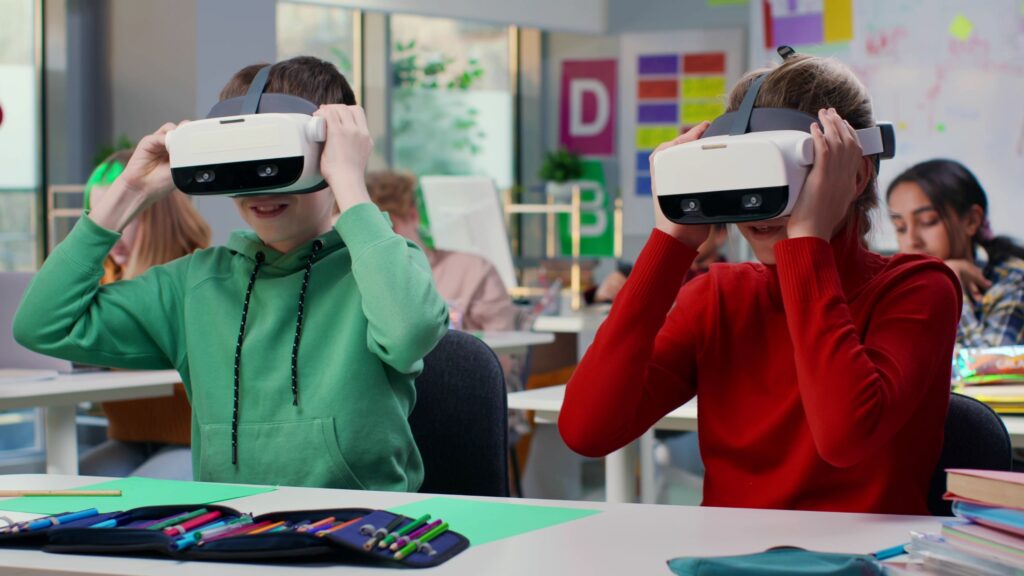Artificial intelligence (AI) has been a part of our daily lives for quite some time without us fully knowing it. However, in recent years, new advancements in AI are causing AI to rapidly become an integral part of our daily lives, whether we like it or not. Many would say that these recent advancements are revolutionizing industries, while others may think that AI may present dangers for society.
One thing that has become clear in education is that AI is transforming the way students learn and educators teach. This article explores the various applications of AI in the classroom and how it’s being used to enhance students’ educational experiences.
Personalized Learning
Customizing instruction in ways that align with student needs has been the consistent charge for schools and districts. This personalization of learning is one of the most significant benefits of AI in the classroom. AI-powered platforms can not only analyze individual learning styles, strengths, and weaknesses, they also allow teachers to tailor their instruction in a way that addresses these essentials for students. AI algorithms are able to recommend specific learning materials, adapt the difficulty of assignments, and provide real-time feedback to help students improve their mastery of skills.
Intelligent Tutoring Systems
With the emergence of virtual and hybrid learning environments, many educators have found it beneficial to assign tutoring programs for learners. Intelligent Tutoring Systems (ITS) are AI-powered programs that act as virtual tutors. These programs provide students with one-on-one instruction and assistance in a virtual educational setting. An ITS can answer questions, provide explanations, and lead students through complex subject matter. By adapting to each student’s instructional pace, ITS ensures that students grasp fundamental concepts before moving on to more advanced topics.
Grading and Assessment
Grading assignments and exams can prove to be a time-consuming task for educators, but AI is able to restructure this process. In fact, standardized writing assessments have utilized this function of AI for several years. Through the use of Optical Character Recognition (OCR) and Natural Language Processing (NLP) technologies, AI systems evaluate written responses and even grade essays with a high degree of accuracy. This saves valuable time for teachers and allows teachers to focus more on providing effective feedback to their students.
Early Intervention
Computerized intervention software that utilizes performance projections to determine how to adapt student learning tasks are powered by AI. These AI systems can detect learning difficulties and potential academic challenges early on for students. By analyzing student performance data, these systems can identify areas where a student may be struggling and alert teachers, administrators, and parents. AI can predict student outcomes quickly and identify at-risk students based on their performance data. This early intervention is crucial to help address learning gaps and prevent students from falling behind. This information also allows educators to provide targeted support and interventions.
Language Learning and Translation
Meeting the needs of multilingual students and students who wish to become multilingual is a priority for schools. The technology used by AI-powered language learning applications and translation tools is revolutionizing how quickly students become proficient in English as well as learn new languages. Because these applications offer real-time translation services, they make foreign language learning more accessible. Surprisingly, this AI can also analyze a student’s pronunciation and provide feedback, which makes language acquisition more effective.
Virtual Reality (VR) and Augmented Reality (AR)
AI is also being integrated into VR and AR technologies, creating immersive educational experience for students in the classroom. Students can now explore historical sites, dissect virtual organisms, go on virtual field trips, or conduct complex experiments in a safe and controlled environment. These experiences are enhanced for students through the use of AI because AI in schools can provide context, guidance, and interactive simulations when used effectively.
Specialized Education
AI can be used to support students with disabilities and special needs. Assistive technologies, such as text-to-speech and speech-to-text applications, can help make educational content more accessible.
Curriculum Development
AI can assist in developing and updating curriculum materials. It can analyze industry trends, student performance data, and emerging research to create relevant and up-to-date content.
Collaboration and Communication
AI-powered tools can facilitate communication and collaboration among students and teachers. Chatbots and virtual assistants can help answer common questions, while language translation tools break down language barriers in diverse classrooms.
Gamification and Engagement
AI can be used to create interactive and gamified learning experiences, making lessons more engaging and motivating for students.
Challenges and Considerations
While AI holds great promise in education, there are several challenges and considerations to keep in mind.
Privacy and Data Security
Collecting and analyzing student data raises privacy concerns. Schools and technology providers must prioritize data security and ensure compliance with relevant regulations.
Equity
Access to AI-powered educational resources may not be equal for all students. Addressing the digital divide and ensuring that AI benefits all learners is a critical consideration.
Teacher Training
Educators need training to effectively integrate AI tools into their teaching practices and maximize their benefits.
Ethical Concerns
AI algorithms can inadvertently perpetuate biases or reinforce stereotypes. Careful design and oversight are essential to avoid these pitfalls.
AI is transforming the landscape of education, offering new ways to engage students, enhance learning experiences, and support educators. While there are challenges to overcome, the potential benefits are vast. By harnessing the power of AI in the classroom, we can create more personalized, efficient, and effective learning environments that prepare students for future challenges. As AI continues to evolve, so will its role in education, opening up exciting possibilities for the generations to come.
Educators never stop learning; check out our available graduate degree programs to hone your skills and promote lifelong learning and academic excellence.




